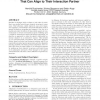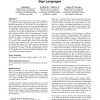62 search results - page 4 / 13 » Gesture Modelling for Linguistic Purposes |
ATAL
2010
Springer
13 years 8 months ago
2010
Springer
Speakers in dialogue tend to adapt to each other by starting to use similar lexical items, syntactic structures, or gestures. This behaviour, called alignment, may serve important...
CHI
2005
ACM
14 years 7 months ago
2005
ACM
Sign languages have been proven to be natural languages, as capable of expressing human thoughts and emotions as traditional languages are. The distinct visual and spatial nature ...
GW
1999
Springer
13 years 11 months ago
1999
Springer
Led by the fundamental role that rhythms apparently play in speech and gestural communication among humans, this study was undertaken to substantiate a biologically motivated model...
COLING
2010
13 years 2 months ago
2010
This paper analyzes the contribution of semantic roles to TimeML event recognition and classification. For that purpose, an approach using conditional random fields with a variety...
ICIP
2003
IEEE
14 years 9 months ago
2003
IEEE
With the rapid technological advances in machine learning and data mining, it is now possible to train computers with hundreds of semantic concepts for the purpose of annotating i...



